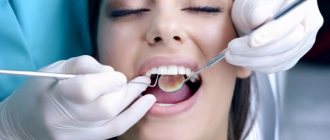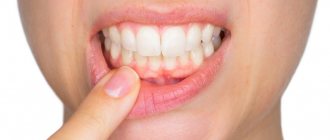26.10.2020 6680
The answer to the question of why teeth turn black must be sought together with the patient. Often, one examination of the oral cavity is not enough; you need to learn more about the person’s habits, hereditary diseases and diet.
Therefore, before visiting the dentist, try to listen to your body and understand what signals it is giving you. If you are being treated with any medications, be sure to write down their names and tell your doctor.
There are many causes of darkening, the most common among them are the following:
- Caries begins. At the initial stage, a person usually develops a white coating, streaks or dots on the enamel. Over time they begin to darken. But there are also those patients in whom caries is expressed in general darkening of the tooth. In this case, the sign will be tingling or aching pain, increased sensitivity to hot, cold, and sour foods.
- She is taking antibiotics. These include medications of the tetracycline class. A side effect of taking them is yellowing of the enamel, but tarnishing is also common. The tooth becomes gray and stands out strongly in the row.
- The body is irradiated or strong treatments are used. Radiation or chemotherapy can affect tooth discoloration.
- There is too much fluoride in the body. This condition is called fluorosis and occurs in both adults and children. It develops due to individual characteristics, consumption of certain types of foods and vitamin complexes.
- The enamel becomes thinner. This phenomenon is observed in most older patients.
- The mouth has fillings based on copper amalgam. These are not used as often now, but they were common in the past. The substance gradually seeps into the oral cavity and affects the color of the enamel of all other teeth.
- The nerve in the tooth has been removed. Over time, all teeth without nerves begin to darken. Dentists always warn about this and therefore try especially hard to save the tooth.
The patient's lifestyle and habits also often cause darkening of the enamel. This phenomenon is observed among smokers and workers in the metallurgical industry.
If your diet contains a lot of foods with strong dyes, including fruits and vegetables, your teeth may also become darker.
To reduce the likelihood of developing a problem, pay attention to oral hygiene. Problems with it stimulate this phenomenon.
Gum necrosis
Causes of necrosis
Types of gum necrosis and treatment
Symptoms of the disease
Diagnosis of the disease
Prevention of the development of gum necrosis
Gum necrosis (from the Greek nekros - dead) is the death of tissue that occurs due to cessation of blood circulation. This disease is difficult to detect at an early stage, as its symptoms are barely noticeable. Another danger is that this process is irreversible. Therefore, if the doctor has diagnosed gum necrosis, it is important to take appropriate measures as soon as possible to prevent the development of pathology. In this article we will look at the causes of necrosis, its types, and also tell you how to avoid it.
Causes of necrosis
Table 1. Causes of gum structure destruction
| Causes of necrosis | How it manifests itself |
| Insufficient oral hygiene | Plaque forms, which leads to the development of gingivitis, periodontitis, and periodontal disease. |
| Injury to the gums due to malocclusion or ill-fitting dentures | This disrupts blood flow and blood circulation stops in certain segments. |
| Hormonal disbalance | During pregnancy, adolescence, with diseases of the endocrine system and blood. |
Sometimes the disease can occur due to prolonged exposure to cold, high temperatures or arsenic, which is part of the dental pastes used in root canal treatment. For example, if a temporary filling does not close the dental canal tightly, the paste can come out, causing tissue necrosis.
Types of gum necrosis and treatment
The treatment plan is developed individually for the patient and depends on the type of necrosis.
Table 2. Treatment plan depending on the type of anesthesia
| Type of gum necrosis | How to determine | Treatment |
| Dry | Dead areas dry out and decrease in volume. There are no signs of inflammation or intoxication. | The affected areas are removed, the surrounding tissues are treated with antiseptics. After the procedure, the doctor prescribes drug therapy. |
| Wet | It is considered the most dangerous form. Accompanied by swelling and increased hyperemia. | They open purulent foci, cut out dead tissue, dry the gums, and carry out antiseptic treatment of the oral cavity. After – drug therapy |
Once the necrotic process has stopped, bone grafting may be required to improve aesthetics.
Average cost of treatment in Moscow
Treatment of complications in dentistry
| Name of service | Cost, rub. |
| Consultations | |
| Dentist | 600 |
| Implantologist | 820 |
| Healing procedures | |
| Removing dental plaque in the area of 1 tooth | 180 |
| Periodontal applications in the area of 1 tooth | 370 |
| Laser therapy of the gum mucosa | 490 |
Treatment at home with medications and folk remedies
| Name of service | Cost, rub. |
| Medications | |
| Chlorhexidine | 16 |
| Rotokan | 38 |
| Metrogil Denta | 230 |
| Vinylin | 260 |
| Folk remedies | |
| Calamus root | 55 |
| Pharmaceutical chamomile | 60 |
| Thyme | 60 |
| St. John's wort | 60 |
| Melissa | 70 |
| Mint | 80 |
| Sage | 120 |
Symptoms of the disease
Signs of the disease differ depending on the stage.
Early.
The tissues are slightly affected, darkening of the enamel and pale gums may be observed.
Average
. Swelling of the interdental papillae, a gray coating forms on the mucous membrane, and bad breath appears.
Heavy.
Swelling of the gum tissue - it turns black and ulcers appear on it. Appetite disappears, body temperature rises to 39 C°.
Last
. The epithelium dies, severe pain is felt in the gums, the necks of the teeth are exposed, and the dental units become loose.
Causes of darkening after implant installation
Hematoma
Darkening of the gums after implantation may be due to the formation of a hematoma. Hematoma is a common postoperative symptom, which is a natural reaction of the body to the presence of a foreign body. Most often it appears a few hours after implantation and goes away within a week. The hematoma reaches its greatest development on the fourth day after the intervention.
Blue discoloration on the gums can occur from an injection of anesthesia. With a favorable prognosis, such darkening is not dangerous and will disappear within a few days, like a hematoma.
Illumination of titanium elements
Even successful placement of dental implants can result in blue gums. When installing an implant and abutment, a blue highlight is possible; the blue color is especially clearly visible on the front teeth. To avoid such an unpleasant effect, when installing implants on the front teeth, you need to opt for zirconium abutments rather than titanium abutments.
Complications during prosthetics
Often darkening is observed after installing crowns on the implant. First, the gums turn red and swell, later they darken and bleed. The cause of the complication is an incorrectly formed gingival contour, if a former was not installed after the implant was implanted. The edges of the crown put pressure on the gum, disrupting blood circulation in it, causing swelling and blue discoloration. Stagnation of blue venous blood especially stands out against the background of white teeth and healthy areas of the gums.
What to do if your gums are darkened
Darkening is a sign that the installation of an implant or subsequent dentures has caused irritation and bleeding of the gums. Therefore, medication administration and monitoring should be carried out by a doctor.
Treatment is prescribed depending on the cause of the pathology. It may be necessary to adjust the implant superstructures or replace the crown or bridge fixation system. At the same time, the doctor will prescribe anti-inflammatory therapy. Massage and physiotherapeutic treatment methods are also indicated.
In case of color change, you should not self-medicate. Immediately contact a specialist to determine the pathology.
The most effective drugs:
- Rotokan . Black gums are rinsed with the solution three times a day.
- Metrogil Denta . Antibacterial gel is applied to the affected area for a month.
- Chlorhexidine bigluconate 0.5% . Rinse the mouth with the solution up to six times a day for several days.
- Vinylin . A compress with balm is applied to the darkened gum and kept for 20 minutes.
Before using folk remedies, consult your doctor because medicinal herbs have serious side effects.
The oral cavity is rinsed:
- a decoction of mint, sage, oregano, lemon balm;
- a decoction of St. John's wort, thyme, chamomile, sage;
- soda solution;
- hydrogen peroxide;
- sea salt;
- infusion of oak bark.
Comment from an implant surgeon with 12 years of experience: “Darkening can be caused by injury to blood vessels during implantation. If the operation is successful, there should be no severe pain, swelling or darkening. Standard complications: pain of moderate intensity, small hematomas, a feeling of fullness in the maxillary sinus, low-grade body temperature, inflammation of the soft tissue in the area of implantation, temporary bleeding.”
Diagnosis of gum necrosis
Often the problem is identified during an examination by a dentist, without any complaints from the patient. In some cases, symptoms are present: pain, bleeding, flushing, bad breath.
Other signs of the disease may include:
- swelling of the mucous membrane;
- digestive problems;
- problems with swallowing;
- deterioration of health.
During diagnosis, the doctor does an X-ray examination and conducts an instrumental examination. The image allows not only to identify the necrotic process, but also to determine the stage, possible complications, etc.
Other diseases that can cause darkening of gums
The appearance of dark spots disrupts the aesthetics of a smile and may indicate serious disorders in the body. Problems with the gums lead to bad breath and pain. This is dangerous due to sleep disturbances, decreased performance, and ignoring communication.
Darkening may be caused by:
- general diseases of the body;
- smoking;
- injury;
- hit by a foreign object;
- complications during treatment and tooth extraction;
- improper installation of dental crowns.
Dental treatment
Before implantation, sanitation of the oral cavity is indicated, which consists of identifying and treating pathological changes. Darkening may occur after dental treatment. When filling teeth, amalgam can be used - an alloy of mercury with one or more metals. This filling material is used for chewing teeth in patients of any age, regardless of the severity of caries.
The disadvantage of amalgam is a reaction to contact of the material with the oral mucosa. It is expressed in the appearance of dark spots on the gums. Spots may appear immediately after treatment or after some time. Such manifestations are not considered a pathology. To improve aesthetics, stains are removed surgically.
General diseases of the body
Darkening may be due to the presence of common diseases. Peutz-Jeghers syndrome is characterized by the presence of dark spots on the skin and mucous membranes. This hereditary disease is diagnosed in early childhood. It occurs as a result of a gene mutation and is accompanied by the growth of hamartomatous polyps in the gastrointestinal tract. Therefore, another name for the disease is hamartomatous polyposis.
Darkening and the formation of dark spots on them do not appear immediately. These symptoms develop with age. External signs of the disease are not dangerous. However, their cause poses a serious threat to the health and life of the patient. Polyps provoke the development of cancer of internal organs. No effective comprehensive treatment for the syndrome has been developed.
Regular examination allows you to monitor the development of the disease. If polyps reach critical sizes, they are removed. Medicines that prevent the appearance of tumors are also prescribed.
Changes in gum color may be a symptom of Addison's disease . This is an endocrine disease with disruption of the adrenal glands, which are unable to produce hormones in the required quantities.
If the disease is present, the dark spots have an irregular shape and may form stripes. Their presence is due to changes in the balance of hormones, provoking melanin deposits. Associated signs of the disease are loss of appetite, general malaise, fatigue, and bronze skin tone.
Black gums and teeth due to smoking
The color change may be due to smoking, because nicotine causes changes in the body that are very difficult to reverse. Smoker's melanosis is characterized by discoloration of the oral mucosa, discoloration of teeth, and an unpleasant odor.
Any diseases of the mucous membrane caused by smoking, under unfavorable conditions, can subsequently become malignant. Therefore, in order to get rid of pigmentation, you should get rid of the main cause, i.e. stop smoking. Afterwards, the spots are removed using laser correction.
- Complete restoration of the dentition in just 4 days!
more detailsRoott Pterygoid Implants Sinus lift is no longer needed!
more details
Once and for life! Express implantation in 4 days with a permanent ReSmile prosthesis
more details
All-on-4, All-on-6, ReSmile, Zygomatic implantation We use all modern methods of dentition restoration
more details
Prevention of the development of gum necrosis
Interventions are often based on maintaining oral health and preventing dental diseases.
- Regular teeth cleaning and professional hygiene.
- Quitting bad habits (smoking, alcohol).
- Timely correction of the bite to prevent trauma to the mucous membrane and accumulation of dental plaque.
- Balanced diet, taking vitamins if necessary.
- Timely treatment of diseases of teeth and gums, gastrointestinal tract, endocrine diseases, etc.
After treating necrosis, it is important to prevent its reappearance. Proper oral care and mandatory visits to the dentist once every six months will help with this.
Causes of darkening of teeth near the gums
The condition of teeth and enamel is affected by many everyday factors, as well as various dental diseases.
Household factors include:
- abuse of coffee, tea, red wine;
- smoking;
- frequent consumption of natural juices (for example, grape or tomato);
- taking certain medications that contain ferrous gluconate.
Coloring drinks provoke the appearance of enamel pigmentation, which is easily eliminated with professional teeth cleaning.
Pathological processes that provoke the accumulation of dark plaque on the enamel in the gum area:
- cervical caries;
- tartar;
- fluorosis (a disease characterized by a high content of fluoride in the human body).
Cervical caries is the most common cause of dark spots on teeth. Pathology is one of the most dangerous types of the carious process, since it occurs in a hidden form, and the destruction of enamel occurs very quickly.
The disease develops in stages:
- A small pigment spot appears in the area of the tooth neck near the gum;
- Then the darkened area of enamel becomes rough;
- The tooth begins to react to external stimuli (sour, sweet, hot, cold), painful sensations appear;
- The stain on the enamel changes color from light brown to black.
The deep form of cervical caries is accompanied by severe destruction and most often turns into pulpitis.











